Traditional Chinese 木須肉 or 木樨肉 Hanyu Pinyin | Simplified Chinese 木须肉 or 木樨肉 Hanyu Pinyin | |
 | ||
Similar Moo goo gai pan, Egg foo young, Chow mein, Egg as food, Lo mein | ||
How to make moo shu pork
Moo shu pork (also spelled mù xū ròu, moo shi pork, mu shu or mu xu pork) is a dish of northern Chinese origin, possibly originating from Shandong. It is believed to have first appeared on the menus of Chinese restaurants in the United States in the late 1960s, and is also a staple of American Chinese cuisine.
Contents
- How to make moo shu pork
- Moo shu pork quick easy chinese cuisine presented by chinese home cooking weeknight
- Chinese
- American Chinese
- Variations
- American Chinese style
- Etymology
- References
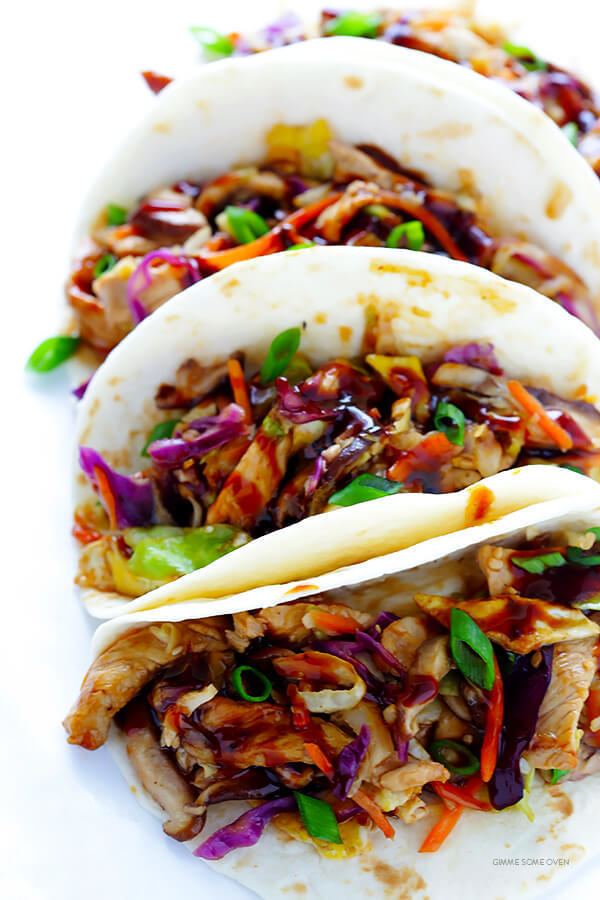
Moo shu pork quick easy chinese cuisine presented by chinese home cooking weeknight
Chinese
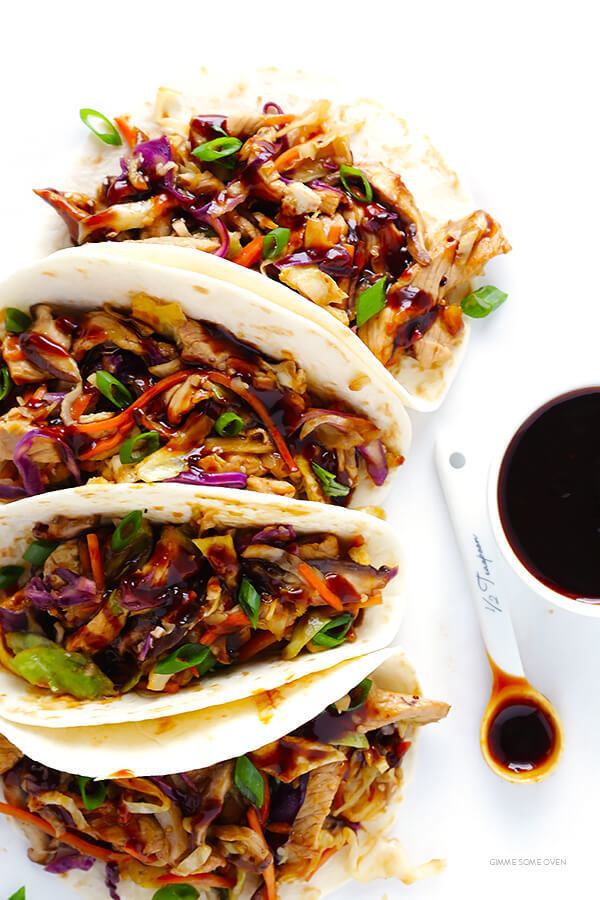
In its traditional Chinese version, moo shu pork (木须肉 / mùxūròu) consists of sliced pork tenderloin, cucumber, and scrambled eggs, stir fried in sesame or peanut oil together with thinly sliced wood ear mushrooms (black fungus) and enokitake mushrooms. The dish is seasoned with minced ginger and garlic, scallions, soy sauce, and rice cooking wine (usually huangjiu).
American Chinese
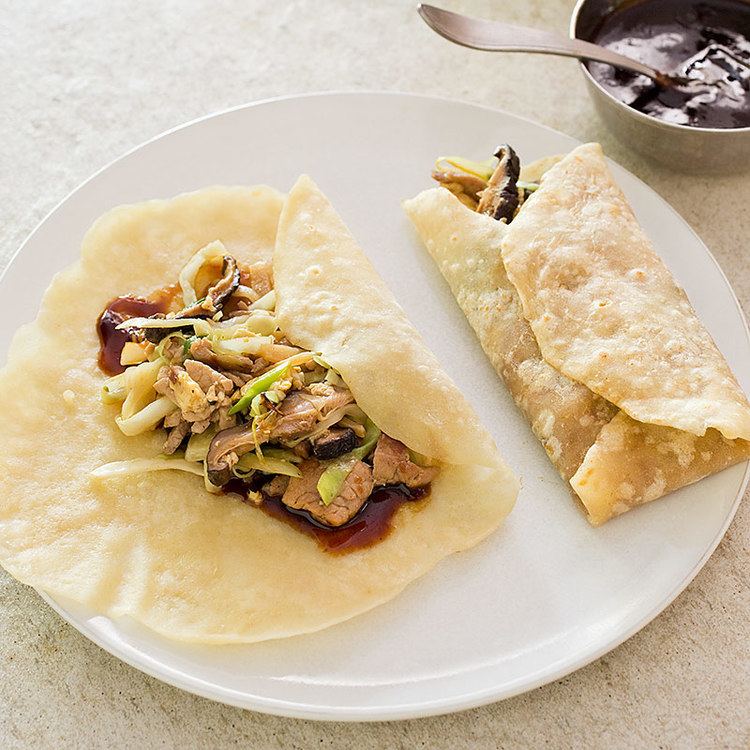
In the United States, the dish seems to have appeared in Chinese restaurants in New York City and Washington, D.C., in approximately 1966, receiving mention in a New York Times guide to Washington, D.C., restaurants published in that year. One of the first restaurants in Manhattan to serve the dish was Pearl's, one of the best known New York City Chinese restaurants to serve non-Cantonese food in the 1960s. A 1967 article in The New York Times states that another of the first restaurateurs to serve the dish in Manhattan was Emily Kwoh, the owner of the Mandarin House, Mandarin East, and Great Shanghai restaurants. The dish was also early on the menu at Joyce Chen's, a celebrated pioneering Mandarin-style restaurant in Cambridge, Massachusetts. At that time, the dish was at first prepared in a traditional manner, but, as wood ears and day lily buds were scarce, a modified recipe was developed. In this modified recipe, which gradually came to predominate in North America, green cabbage is usually the predominant ingredient, along with scrambled eggs, carrots, day lily buds, wood ear mushrooms, scallions, and bean sprouts. The new recipe is more like the filling of Chinese Spring pancake. Shiitake mushrooms, bok choy, snow pea pods, bell peppers, onions, and celery are sometimes also used, and dry sherry is often substituted for the huangjiu. The vegetables (except the day lily buds and bean sprouts) are generally sliced into long, thin strips before cooking.
Variations
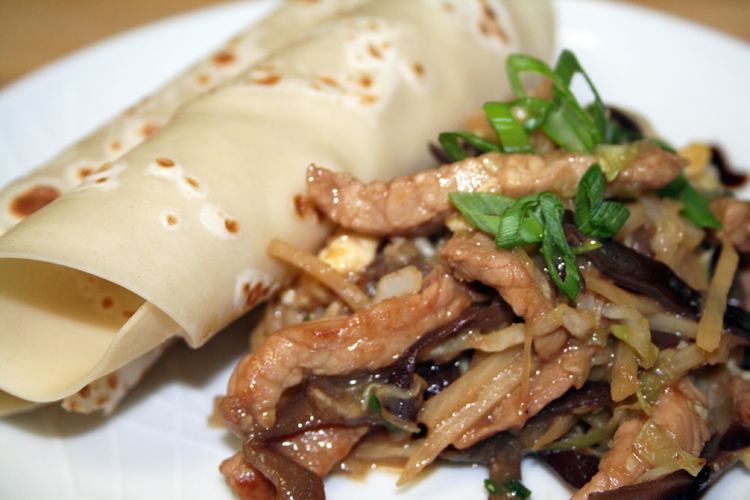
While these are the typical ingredients, there is some variation in the recipe from chef to chef or restaurant to restaurant. In both the Chinese and Americanized versions, monosodium glutamate, salt, sugar, corn starch, and ground white pepper are also often added. In less authentic North American restaurants, the wood ears and day lily buds (ingredients less familiar to most American customers) are often omitted entirely.
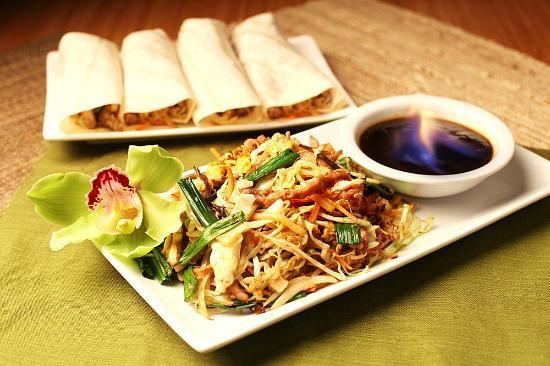
Although most commonly made with pork, the same basic dish can be prepared by substituting another meat or seafood; generally only a single meat is used. If made with chicken instead of pork, the dish is called moo shu chicken, and the name is similarly altered if prepared with beef, shrimp or tofu. If prepared without any meat, it is called moo shu vegetables. Many Chinese families use chicken but shrimp and beef are less common in home cooking.
Lu (卤), meaning gravy, is also made up by the standard ingredients of moo shu pork, including day lily, wood ear, soy sauce, and starch. Lu or dalu (打卤), with gravy, similar to au jus in Western cuisine. Lu, either vegetarian or with eggs or meat, is often used as a soup base for noodles (Dalu noodles). It can be like either a sauce or a soup. Lu is also used in a breakfast setting over soft tofu, often at Chinese halal fast-food places.
Chinese
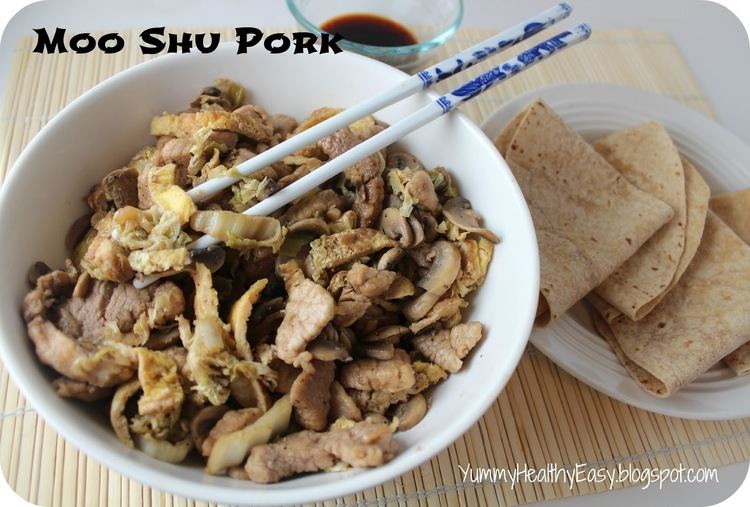
Moo shu pork is usually served with rice in China. Moo shu Lu, the gravy variation, is more often served with noodles and soft tofu.
American Chinese style
In America, Moo shu pork is served with a small dish of hoisin sauce and several warm, steamed, thin, white tortilla-like wrappers made of flour, called "moo shu pancakes" (Chinese: 木须饼, pinyin: mù xū bǐng), báo bǐng (薄饼, literally "thin pancakes") or just called "Mandarin pancakes"; these are similar to those served with Peking Duck. In the late 20th century, some North American Chinese restaurants began serving Mexican-style flour tortillas, which are thicker and more brittle, in place of the traditional moo shu wrappers.
The moo shu pork is then wrapped in the moo shu pancakes, which are eaten by hand in the manner of a taco. The diner may wrap his or her own pancakes; in some Chinese restaurants, waiters or waitress will do so. First, a small amount of hoisin sauce is spread onto the pancake, then some moo shu pork is placed in the center of the pancake. The bottom of the pancake is folded up (to prevent the contents from falling out), then the sides of the pancake are folded or wrapped, in the manner of a soft taco.[1] Unlike the practice in wrapping a burrito, the top is usually not folded over, as the pancake is generally eaten immediately and thus there is no danger of the food falling out of the top, which is the part that is eaten first. Because the dish often contains a great deal of liquid, care must be taken that the pancake does not become soaked through and break during rolling or eating.
Etymology
There are two primary histories for how the name of this dish is to be written and explained.
One story gives the name as 木犀肉 (pinyin: mù xī ròu). The last character 肉 (ròu) means "meat" and refers to the pork in the dish. The first part 木犀 (mù xī) is the name for the Sweet Osmanthus: a small ornamental tree that produces bunches of small and fragrant blossoms that may be yellow or white.
Scrambled eggs have an appearance that remind people of the mixed yellow and white flowers, so 木犀 (mù xī) is a poetic way of referring to the scrambled eggs used in preparing this dish. Additionally, at Chinese Confucian death anniversary celebrations, the Chinese word for "egg" (蛋; pinyin: dàn) is avoided when referring to dishes containing eggs, as many Chinese curses contain this word. Thus, the word dàn was typically substituted using the euphemism "Sweet Osmanthus." By this reasoning, in this version of the dish's name, the first character, 木 (mù) is short for 木耳 (mù'ěr, meaning "wood ear fungus") and 樨 (xī, meaning "Sweet Osmanthus tree") is short for 桂花 (guíhuā, meaning "Sweet Osmanthus flower").
The second way of writing the name of this dish that is commonly seen in Chinese restaurants in the United States is 木须肉 (pinyin: mù xū ròu). The second character 须 (xū) means "whiskers," and is often given an additional determinative component in writing (to distinguish the meaning of "whiskers" from the other meanings of 須) so that it comes to be written as 鬚. It is possible that 木須肉 (literally "wood whiskers pork") might have been used on the menus of the first American Chinese restaurants to serve the dish in place of the correct compound 木樨肉 ("sweet osmanthus pork") due to haste or simply because of the limitations of Chinese typewriters. It may also merely have been the result of writing the wrong character with a similar pronunciation.
Two additional explanations of the name have unclear origins and may be examples of folk etymology: There is a neighborhood with a similar name in Beijing called Muxi Di (木樨地), which is home to the Muxi Di train station (木樨地站). The dish is also occasionally also called 苜蓿肉 (mùsù ròu) meaning "alfalfa meat".
